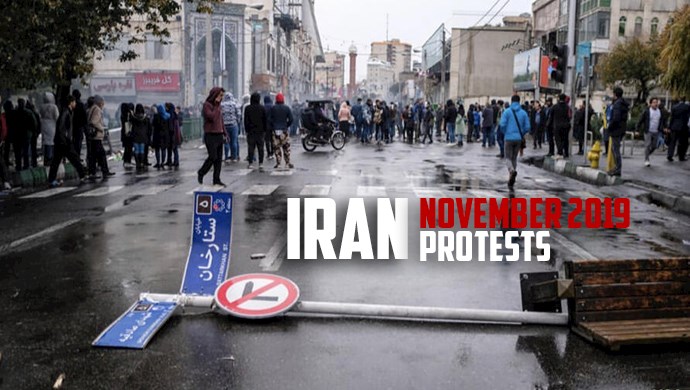Analysis by PMOI/MEK
Iran, November 12, 2020—On Friday, November 15, 2019, after months of discussions, the Iranian regime declared a 50-300 percent price hike in the price of gasoline. On the same night, the Iranian people, frustrated from economic constraints, poured into the streets in different cities to voice their outrage at the government’s policies.
From early Saturday morning of November 16 people began lighting fires in the streets, turning off their vehicles to block roads and closing highways and other paths leading to the country’s cities. The protests quickly spread to more than 190 cities across the country and turned into a nationwide rally against the regime.
Demands for decrease in gasoline prices turned into slogans calling for regime change. “Death to [supreme leader Ali] Khamenei,” “Death to the dictator” and “Dictator, let go of the country,” slogans that were previously a taboo under the suppressive rule of the mullahs, were chanted by large crowds in the streets of many cities.
Fire under ashes
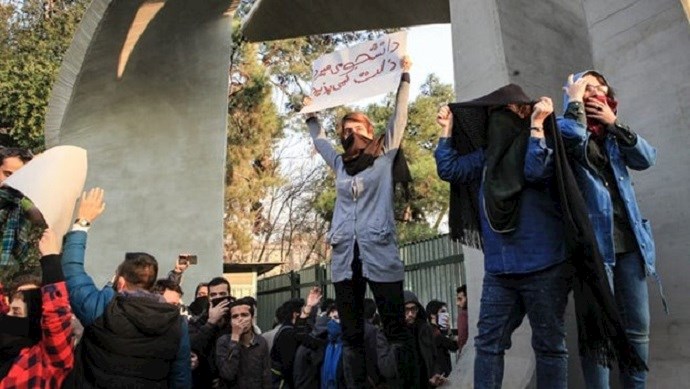
Iranian security forces violently quelled nationwide protests in 2017-2018
Less than two years before, the people of Iran had held another widespread uprising at the end of December 2017 and early days of January 2018. At the time, the regime had been benefitting immensely from the economic bonanza it had obtained through the nuclear deal with world powers. Oil exports were at a decade high, with more than 2.5 million barrels per day, and the regime was reaping billions of dollars in oil revenue and trade with other countries. However, the one thing that had not changed was the livelihoods of the people. As the regime continued to get richer, Iran’s people were getting poorer by the day.
The December 2017 protests were also triggered by economic woes and the public’s resent toward corrupt officials who were only concerned with amassing wealth for themselves and spending Iran’s resources on terrorism, proxy wars, and nuclear missiles.
While the regime managed to stifle the protests through the use of sheer force, it did not succeed in quelling the growing feeling of outrage and resent across the increasingly impoverished population.
In November 2019, the simmering hatred of the regime exploded again as people took to the streets to voice their protests.
Protesters resist crackdown by security forces

Security forces were dispatched to quell protests after demonstrations erupted across Iran in November 2019
The regime’s forces responded to the peaceful demonstrations by attacking the people and breaking their vehicle windows in the streets.
The people, who were fed up with 40 years of suppression and corruption by their rulers, were not going to be subdued this time. In response to the regime’s suppressive measures, they targeted centers controlled by the regime, including banks, gas stations, police stations, governor’s offices, police trailers, vehicles and motorcycles belonging to security forces, bases of the Revolutionary Guards (IRGC) and Basij paramilitary forces, supermarkets linked to the IRGC, and offices of Khamenei’s representatives.
Most of these clashes were reported in the cities of Shahriar, Shahr-e Quds, Shiraz, Behbahan, Isfahan and Tehran.
“The incidents of the past few days… were somewhat different from the seditions of previous years because to some extent political motivations were formed in the wake of economic protests,” said Alireza Adiani, Khamenei’s representative in the state police force on November 21, 2019, according to the state-run Basij News outlet.
“As an individual on the ground I believe only God saved us,” said Basij commander Brigadier General Salar Abnush, according to the semi-official ISNA news agency.
“On the first day 28 provinces and 100 cities and areas were engaged with this issue,” said deputy IRGC chief Ali Fadavi on November 22, 2019.
“In five provinces we were engaged in far more intense crises,” said regime Interior Minister Abdolreza Rahmani Fazli on November 26, 2019. “On Saturday, November 16 in Tehran there were 100 areas reporting incidents and clashes… More than 50 police and military bases were attacked… we were forced to shut down the internet temporarily and in specific areas,” he added, according to the regime’s official IRNA news agency.
Shiraz was the main city with the utmost protests and clashes. Locals were still in deep grief from the March 2019 floods in this city which saw no relief efforts by the government. On the first and second day of the uprising at least 120 Basij and police bases, military bases, the regime’s religious sites, gas stations and banks were destroyed by locals. People had gained control over many areas of Shiraz and had practically blocked the main road connecting Shiraz to Tehran. Authorities brought helicopters and sprayed bullets from above onto the demonstrators to regain control over the city.
Khamenei orders the slaughter of protesters
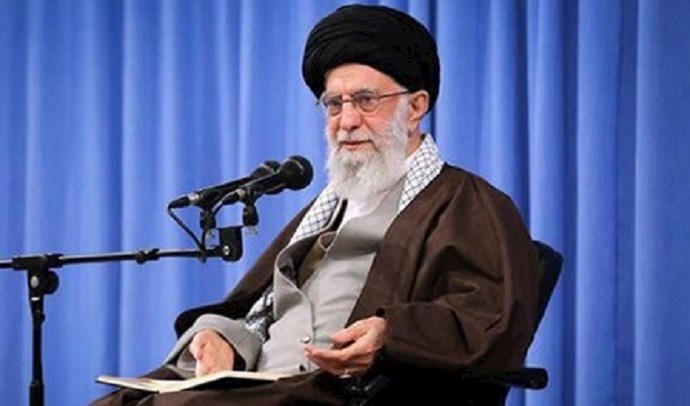
Iranian regime supreme leader Ali Khamenei orders the slaughter of protesters
On Sunday, November 17, Khamenei associated this uprising to the Iranian opposition People’s Mojahedin Organization of Iran (PMOI/MEK) and ordered an all-out crackdown.
“These people are thugs. Who is responsible for arson and destruction and fights and creating insecurity? They should understand this and pay attention to this. The people must understand this as well and distance themselves from these people. This is our suggestion. The country’s officials must live up to their responsibilities and take serious action,” Khamenei said.
“You see that over the past two days, the two nights and one day, in which these incidents happened, all of the world’s centers of evil have encouraged these actions against us…The wicked and criminal collective of the hypocrites (the regime’s derogatory reference to the MEK), they are constantly encouraging and inviting people on social networks and elsewhere to conduct these evil acts.”
“Do whatever it takes to end it,” Khamenei told top security and government officials, according to a Reuters report.
These remarks by Khamenei shed light on his deep concerns about the uprising overthrowing his entire regime. He issued orders for a massive crackdown, allowing his forces to launch a killing spree. As a result, they gunned down at least 1,500 people.
Following Khamenei’s orders, security forces began shooting demonstrators in the head and raising the number of casualties to create fear among protesters. Blind and widespread arrests in the streets, authorities going to hospitals and controlling the injured, taking dead bodies from the morgues of cemeteries, and controlling the computer systems of forensics in order to cloak the true number of deaths were among the other measures used to crackdown the protests.
In Shahr-e Quds, the governor of this town said proudly that she had ordered security forces to shoot at anyone entering the governorate building. Afterwards, the regime’s Interior Minister literally praised her measures and strengthened her position at her post.
The regime’s security forces used snipers, rifles, armored vehicles, helicopters and large-caliber machine guns against protesters.
In Mahshahr, armed security forces chased down local youths and forced them into a marsh area. Then they opened fire with heavy machine guns (.50 caliber/12.7 mm) on the young men hiding in the marshes, killing more than a hundred people.
Mahshahr, southwest #Iran
Footage of the mullahs’ vicious killing spree in this city.
Voice heard saying, “Viva the youth of Jarahi,” referring to a district in Mahshahr. Reports indicate the IRGC killed 40 to 100 locals, and possibly more.#IranProtestspic.twitter.com/HzJu1EVVR4— People’s Mojahedin Organization of Iran (PMOI/MEK) (@Mojahedineng) December 3, 2019
The scope of the regime’s crackdown in November 2019 was without a doubt unprecedented in the regime’s four-decade history.
On December 6, 2019, Michelle Bachelet, the UN High Commissioner for Human Rights, raised concern about the regime’s use of force against protesters.
“Verified video footage indicates severe violence was used against protesters, including armed members of security forces shooting from the roof of a justice department building in one city, and from helicopters in another,” Ms. Bachelet asserted.
She added that OHCHR has also received footage showing security forces shooting unarmed demonstrators from behind as they ran away and other straight on “in other words shooting to kill”.
“These are clear violations of international norms and standards on the use of force, and serious violations of human rights”, underscored the human rights chief.
Crackdown on internet access
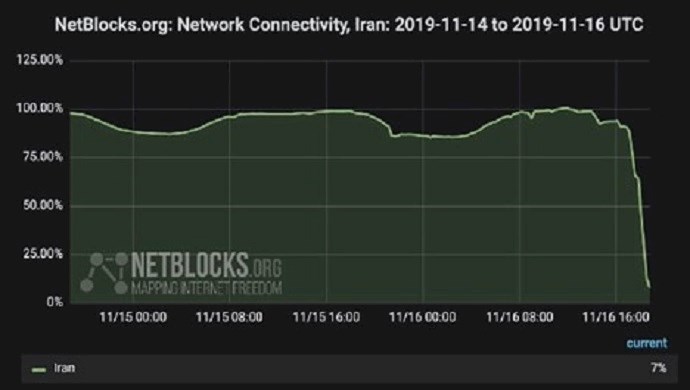
Internet access was shut down across Iran during the protests
As protests continued to spread across Iran, the regime cut off access to internet in order to prevent news of the uprising from being broadcast across the globe. On November 16, internet access across Iran dropped to an all-time low. The blockade continued for several days.
NetBlocks, an organization that tracks internet access across the world, declared that the Iranian regime had imposed a “near-total internet shutdown” after protests erupted over fuel prices. According to the organization’s website, national connectivity reached 5 percent of ordinary levels. “The ongoing disruption constitutes a severe violation of the basic rights and liberties of Iranians,” NetBlocks declared on its Twitter account.
According to NetBlocks, every day of internet blackout in Iran caused nearly $370 million in damages to the country.
Update: It has now been 24 hours since #Iran implemented a near-total internet shutdown following hours of partial blackouts amid widespread protests.
The ongoing disruption constitutes a severe violation of the basic rights and liberties of Iranians
https://t.co/1Al0DT8an1 pic.twitter.com/i7sudrB3I4
— NetBlocks.org (@netblocks) November 17, 2019
But this did not stop the demonstrations, and protesters continued to come to streets for several days amidst the internet shutdown.
In the hospital where I work, they brought 56 dead bodies last night
Meanwhile, the regime ramped up repression after cutting off access to internet. Harrowing reports obtained by the MEK’s network through alternate communications during the internet blackout indicated massive violence by security forces. “In the hospital where I work, they brought 56 dead bodies last night… Please, send this message to the world,” one MEK activist from Shahriar wrote.
As the blackout continued, so did the violence.
Update: #Iran has now been offline for 52 hours following a government-imposed internet shutdown targeting widespread public protests.
National connectivity remains at just 5% of normal levels, leaving Iranians cut off from the world #Internet4Iran
https://t.co/1Al0DT8an1 pic.twitter.com/F5Y9nBdnOJ
— NetBlocks.org (@netblocks) November 18, 2019
The role of MEK Resistance Units in the November 2019 protests
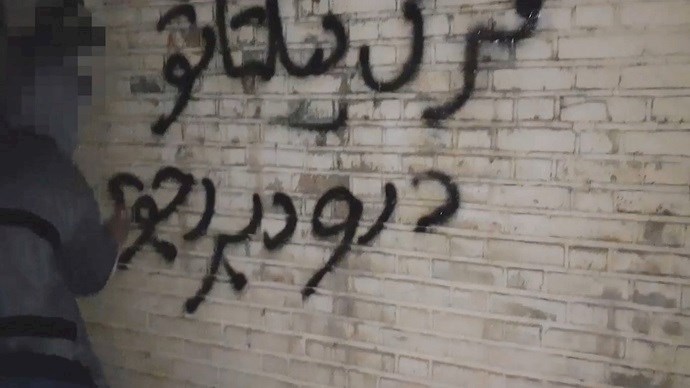
Iranian Resistance Units played a key role in organizing protests
One of the key differences between the November 2019 uprising and previous protests was the highly organized nature. Protesters managed to maintain their unity despite heavy repression and lack of access to communications technology.
One of the key elements that contributed to the consistency of the protests were Iranian Resistance Units, networks of MEK supporters and activists who have been leading anti-regime activities and keeping the flame of uprising alive against the atmosphere of fear imposed by the regime.
On November 17, 2019, Ali Shamkhani, chair of the regime’s Supreme National Security Council, held a press conference focusing on the nationwide protests. “These individuals are linked to the PMOI/MEK… I believe we have arrested 34 MEK members so far and identified a large network of channels that are active not under the MEK banner but following their modus operandi,” he said.
Furthermore, heroic women played an incredibly significant role in the November 2019 uprising, showing practical leadership on the streets, bravery and the remarkable speed necessary that is needed in uprisings. On November 25, 2019, Ramezen Sharif, spokesperson of the IRGC, described the leading role of female protesters as “a new tactic,” according to the regime’s Khabar Fori website.
The legacy of the November 2019 protests
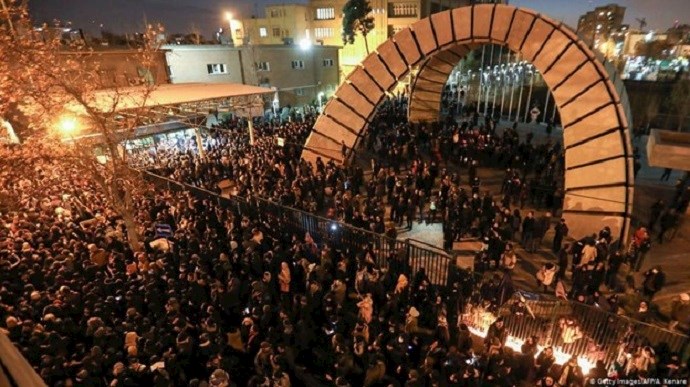
Iranian people returned to the streets less than two months after the November 2019 protests
In November 2019, the Iranian people, with their unprecedented struggle and firm chants made it crystal clear that the freedom-loving movement in Iran has entered a new phase, and the mullahs’ regime, with all its factions that are the main source of the Iranian people’s miseries, are at the center of this face-off with the people.
If the word on the ground during the December 2017/January 2018 uprising was the end of the reformists/principalists scenario within the regime, in November 2019 Iran the people entered a path of uprising to realize their democratic alternative as the only solution forward.
And the regime’s brutal crackdown did not quell the people’s yearning for freedom in Iran. Less than two months after the November 2019 protests, Iranian people returned to the streets and held demonstrations. This time, the protests began after the IRGC shot down a civilian airplane flying from Tehran to Ukraine. But the slogans chanted in the protests were more of what we saw in 2019: the people made it clear the regime has to go.

Protesters face off against security forces — January 2020
A year after the November 2019 uprisings, the regime is still in fear of popular protests re-emerging across the country, this time even more intense than before. And meanwhile, protests and strikes continue every day in Iran, and the Resistance Units continue to undermine the regime’s efforts to spread fear and terror in the society.
On the anniversary of the November 2019 protests, Mrs. Maryam Rajavi, the president-elect of the National Council of Resistance of Iran (NCRI), said, “[The November 2019 uprising] was a manifestation of the burning determination that will continue to carry on until the mullahs’ religious dictatorship is overthrown. This uprising will carry on until the regime is overthrown in its entirety… The clear and definitive conclusion of the developments of the past year since the November uprising is that there will be an irreversible and overpowering face-off between the Iranian society and the religious fascism. From a political standpoint, this is the beginning of the destruction of the foundations of the regime by the Iranian people and ultimately uprooting it.”


